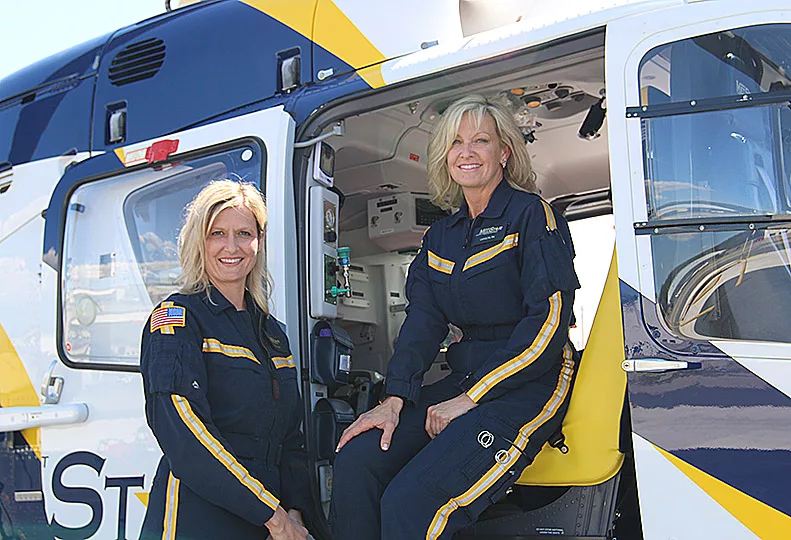_web.webp?t=1761203329)
Home » Northwest MedStar bucks trend
Northwest MedStar bucks trend
Nearly half of medical flight staff is women, despite more men entering field

June 4, 2015
Female nurses and respiratory therapists working for Northwest MedStar constitute nearly half the organization’s in-flight staff, this despite the fact that across the country men tend to outnumber women by a wide margin.
Although there isn’t an official gender count in the U.S., anecdotally, Nicole Stewart, the director of marketing and communications for Inland Northwest Health Services, which operates Northwest MedStar, says the critical care transport service’s 45 percent female-to-male flight staff ratio runs higher than the rest of the industry.
Their occupation started during World War II. It was the first time female nurses took to the skies in aircraft as part of units to help assist in the rescue, removal, and treatment of wounded soldiers on battlefields.
“This industry was derived from the military,” says Carolyn Prouty, a registered nurse for Northwest MedStar. “There were no men nurses; all women. They were put into cargo planes. Later, in Vietnam, they used helicopters to get soldiers out of hotspots.”
While more men through the years have pursued nursing as a profession, more than half of Spokane-based MedStar’s 48 transport registered nurses are women, Stewart says. By comparison, men who are registered respiratory therapists (RRT’s) for MedStar outnumber women. There are 23 male RRTs to nine women, Stewart says. MedStar has a combined total of 80 RNs and RRTs, with 45 percent being women, she says.
The U.S. Census Bureau issued a report in 2013 that said almost 10 percent of registered nurses in the U.S. were men, compared with 3 percent in 1970. However, in the air medical field, men are much more inclined to choose a profession as a registered nurse, says Elena Sierra, membership manager for the Association of Air Medical Services, in Alexandria, Va.
“I do know that we have a higher rate of male nurses compared to the rest of the health care industry overall,” Sierra says.
MedStar has been providing critical care transport for a multistate region for more than 20 years, Stewart says. The service formed in 1994 with the merging of Spokane’s Heartflight and Lifebird programs, she says.
MedStar has operational bases providing 24-hour, seven-day-a-week service in Spokane, Pullman, Moses Lake, Richland, and Brewster, Wash., and in Missoula, Mont. Each location has at least one helicopter serviced and stored in hangars for emergencies.
The Brewster and Missoula bases were added last year. In 2015, MedStar anticipates that it will conduct approximately 6,000 transports using a fleet that includes nine helicopters, five airplanes, and seven emergency medical vehicles.
Last year, MedStar conducted more than 5,500 transports, Stewart says.
“We are a flying intensive care unit,” she says. “Our RNs, RRTs, nationally registered paramedics, and specialty perinatal flight teams provide a level of care that is similar to the critical care or specialty care unit at the receiving hospital.”
Prouty has worked for MedStar for nine years.
She worked as an RN at Sacred Heart Hospital before that. When her two children were younger, they both had to be airlifted by MedStar on different occasions to receive medical treatment.
Her son suffered an acute asthma attack, while her daughter suffered a serious injury in a trampoline accident. Prouty flew with flight crews both times as mom, not as a flight nurse.
While traveling at speeds that can approach 160 miles per hour, Prouty says she was impressed by the way nurses treated both her children.
“I always looked up to those nurses who flew,” Prouty says. “They were professional and composed. As a mother, that meant so much to me.”
It was never Prouty’s intention to be a flight nurse, even though she developed a love of flying through a family friend as a child. She cherished her job as an intensive care nurse at Sacred Heart. Finally, she decided to apply for a position with MedStar, she says.
Her colleague, Kari Zabala, has a story similar to Prouty’s regarding how she ended up at MedStar. An RRT, Zabala worked in the pediatric intensive care unit at Sacred Heart before getting hired at MedStar in 2002.
“I knew some of them, but I never thought about it,” she says of applying to be on MedStar’s medical staff.
That changed when her children got older and they became more self-sufficient, she says.
Both Prouty and Zabala say the job of flight medic can be just as stressful as it is rewarding.
“The amount of experience that is here gets shared and passed around,” Zabala said. “The guidance that I got from veterans at the beginning is so important because without it, it would be a very difficult job to perform,” she says.
“It’s an amazing group of people to work with here,” Prouty says. “People are very supportive of each other, those who they serve, and they are geared toward excellence.”
Latest News Up Close Health Care
Related Articles
Related Products




